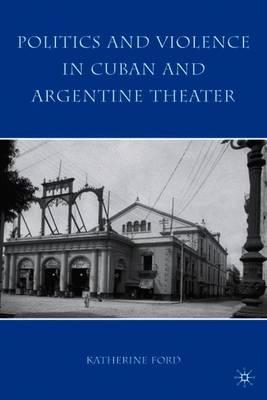Overview
This book looks at Cuban and Argentine theater of the late 1960s and early 1970s to see how the idea of spectacle as violence was used to comment on and question the social and political violence that was unfolding offstage.
Full Product Details
Author: K. Ford
Publisher: Palgrave Macmillan
Imprint: Palgrave Macmillan
Dimensions:
Width: 14.00cm
, Height: 1.70cm
, Length: 21.60cm
Weight: 0.435kg
ISBN: 9780230613140
ISBN 10: 0230613144
Pages: 219
Publication Date: 17 March 2010
Audience:
Professional and scholarly
,
Professional & Vocational
Format: Hardback
Publisher's Status: Active
Availability: Out of stock

The supplier is temporarily out of stock of this item. It will be ordered for you on backorder and shipped when it becomes available.
Reviews
<p>“Ford sets up appropriate chronological and geographical goals as she deals with the complex topic of violence and its theatrical representations. The fact that the author chooses two countries – Cuba and Argentina – considered culturally different within Spanish America with extremely distinguished theatrical histories and also very turbulent political ones in the twentieth century, allows her to uncover the diverse manifestations of psychological, physical, and political violence in a period of six years of theatrical production: 1968-1974. These years are profoundly significant in the two countries’ political development since they represent periods when repression was particularly blatant. This book will be an asset to specialists in the field of Spanish American theater, and to students and scholars interested in examining the issue of violence in Spanish American literature.”--Priscilla Meléndez, University of Connecticut
"""Ford sets up appropriate chronological and geographical goals as she deals with the complex topic of violence and its theatrical representations.The fact that the author chooses two countries - Cuba and Argentina - considered culturally different within Spanish America with extremely distinguished theatrical histories and also very turbulent political ones in the twentieth century, allows her to uncover the diverse manifestations of psychological, physical, and political violence in a period of six years of theatrical production: 1968-1974. Theseyears are profoundly significant in the two countries political development since they represent periods when repression was particularly blatant.Thisbook will be an asset to specialists in the field of Spanish American theater, and to students and scholars interested in examining the issue of violence in Spanish American literature."" - Priscilla Meléndez, University of Connecticut"
Ford sets up appropriate chronological and geographical goals as she deals with the complex topic of violence and its theatrical representations.The fact that the author chooses two countries Cuba and Argentina considered culturally different within Spanish America with extremely distinguished theatrical histories and also very turbulent political ones in the twentieth century, allows her to uncover the diverse manifestations of psychological, physical, and political violence in a period of six years of theatrical production: 1968-1974. Theseyears are profoundly significant in the two countries political development since they represent periods when repression was particularly blatant.Thisbook will be an asset to specialists in the field of Spanish American theater, and to students and scholars interested in examining the issue of violence in Spanish American literature. --Priscilla Melendez, University of Connecticut
<p> Ford sets up appropriate chronological and geographical goals as she deals with the complex topic of violence and its theatrical representations. The fact that the author chooses two countries - Cuba and Argentina - considered culturally different within Spanish America with extremely distinguished theatrical histories and also very turbulent political ones in the twentieth century, allows her to uncover the diverse manifestations of psychological, physical, and political violence in a period of six years of theatrical production: 1968-1974. These years are profoundly significant in the two countries' political development since they represent periods when repression was particularly blatant. This book will be an asset to specialists in the field of Spanish American theater, and to students and scholars interested in examining the issue of violence in Spanish American literature. --Priscilla Melendez, University of Connecticut
Author Information
KATHERINE FORD, Assistant Professor of Hispanic Studies at East Carolina University, USA.



